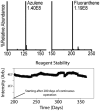Front-end electron transfer dissociation: a new ionization source
- PMID: 23909443
- PMCID: PMC3822909
- DOI: 10.1021/ac401783f
Front-end electron transfer dissociation: a new ionization source
Abstract
Electron transfer dissociation (ETD), a technique that provides efficient fragmentation while depositing little energy into vibrational modes, has been widely integrated into proteomics workflows. Current implementations of this technique, as well as other ion-ion reactions like proton transfer, involve sophisticated hardware, lack robustness, and place severe design limitations on the instruments to which they are attached. Described herein is a novel, electrical discharge-based reagent ion source that is located in the first differentially pumped region of the mass spectrometer. The reagent source was found to produce intense reagent ion signals over extended periods of time while having no measurable impact on precursor ion signal. Further, the source is simple to construct and enables implementation of ETD on any instrument without modification to footprint. Finally, in the context of hybrid mass spectrometers, relocation of the reagent ion source to the front of the mass spectrometer enables new approaches to gas phase interrogation of intact proteins.
Figures







References
-
- Alley WR, Jr, Mechref Y, Novotny MV. Rapid Commun Mass Spectrom. 2009;23:161–170. - PubMed
Publication types
MeSH terms
Substances
Grants and funding
LinkOut - more resources
Full Text Sources
Other Literature Sources

